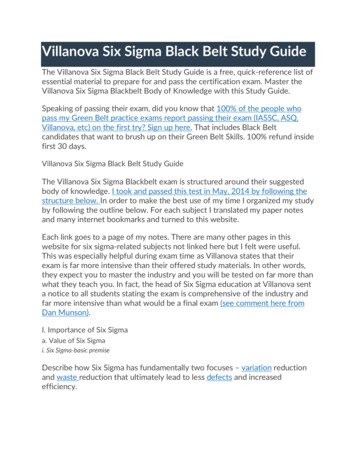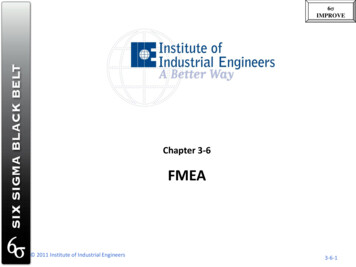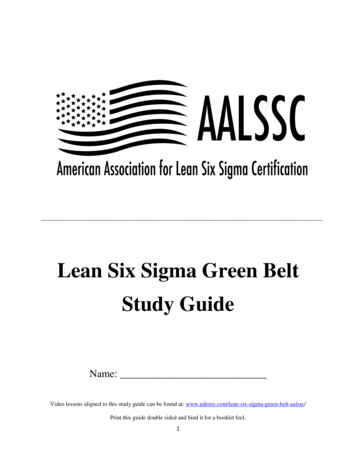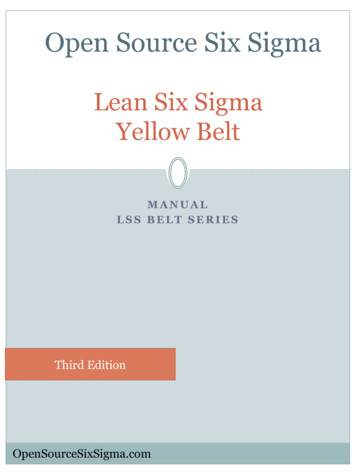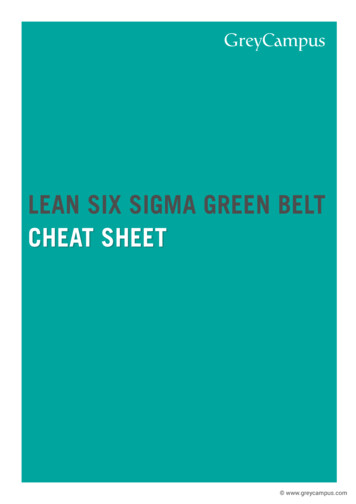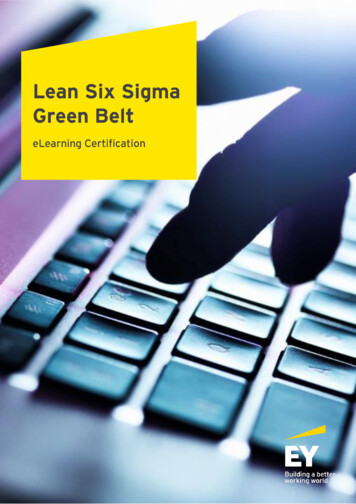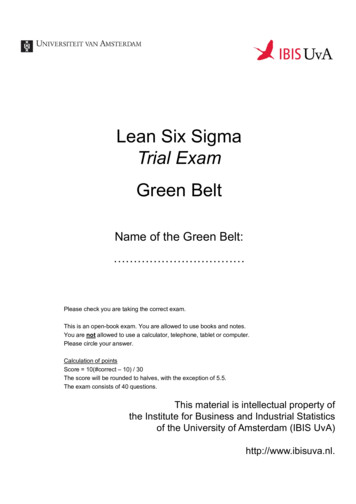
Transcription
--------------------------------------------Lean Six Sigma Black BeltStudy GuideName:Print this guide double sided and bind it for a booklet feel.
Letter from the President,First, let me congratulate you for pursing your Lean Six Sigma Green Belt certification and welcome to the AmericanAssociation for Lean Six Sigma Certification (AALSSC). Obtaining a Lean Six Sigma certification is one of the mostrewarding and valuable professional accomplishments. You will feel an increase in self-confidence, more capable whenleading people and problem solving abilities well above your peers. The professional opportunities for a Lean Six SigmaBlack Belt are vast and across all industries. This is an exciting time for Lean Six Sigma professionals and I welcome youto the community.The amount of knowledge required for an AALSSC certification is extensive, but not overwhelming. You can do it! Thecore tenants of AALSSC are relevant and attainable certifications. By focusing on relevance it drives us to remove someareas of study deemed not relevant enough – making the exam more attainable. As a certified Lean Six Sigma Black Beltyou will be expected to effectively facilitate strategic planning sessions, lead change management efforts, and mentorGreen Belts. The exam tests your knowledge, skills and abilities across these focus areas.This is your study guide, treat it as such. Write your name on it, complete it using your words and follow the conceptsoutlined. By writing you will retain the information and make this study guide a useful part of your reference library. Plus,this study guide can be used when taking an AALSSC Green Belt certification exam.Good luck and welcome to AALSSC – your road to success.Reminder: Black Belts are expected to have complete knowledge of the all Green Belt topics in addition to the Black Beltknowledge areas.Erik ChristensenMr. Erik ChristensenAALSSC President
Table of ContentsOverviewQuality and competitivenessISO 9000, Baldrige National Quality Award and other quality awardsOrganizational structure and role of the Black BeltBusiness performance and Financial measuresCustomer loyaltyFoundations of Lean Six SigmaTotal quality managementStatistical process controlStrategic PlanningTraditional planning processHoshin KanriBalanced scorecardAdditional methodsBenchmarkingSystems thinkingTheory of constrainsProject management and critical chain project managementAdditional Lean Six Sigma methodsTotal productive maintenanceKanbanQuality Function DeploymentDesign for Six Sigma7 quality toolsEnterprise value stream mappingKotter’s 8 stages of change
Quality and CompetitivenessConcept: Competition is global and requires companies to actively improve processes.What is current business environment? What is total quality and how is it defined? What are all the cost stemming frompoor quality?My Notes:
ISO 9000 and Baldrige AwardConcept: Governments and organizations try to facilitate high quality products and waste reduction by usingorganizational certifications and awards.Research and describe ISO 9000, Malcolm Baldrige and other quality focused programs.My notes:
Organizational structure and role of the Black BeltConcept: For a successful Lean Six Sigma transformation the organization must be organized correctly with defined rolesand responsibilities.What does the basic Lean Six Sigma organizational structure look like? What are the various roles of a Lean Six Sigmaorganization and what responsibilities does each have? What qualities should a Black Belt possess? What are commonorganizational road blocks to Lean Six Sigma implementation?My notes:
CertificationsConcept: The most relevant, useful, and valuable Lean Six Sigma certifications are Green, Black and Master Black. Allother certifications have diminished return on investment and therefore not offered by AALSSC.MBBExperienced Black Belt with ability to leadorganization through an entire transformationBlackBeltLeading strategic level projects/kaizen events andfacilitating strategic planning sessionsGreenBeltLeading tactical level projects/kaizen events at thefront lineMy notes:
Business Performance MeasuresConcept: Key Performance Indicators are quantifiable measures tied to organizational success.Research and describe KPIs. What are common KPIs found in organizations today? Research and be able to calculateDefects per unit (DPU), Defects per million opportunities (DPMO), First time yield (FTY), and Rolled throughput yield(RTY).My notes:
Customer loyaltyConcept: Customers are viewed as long term assets; therefore, customer retention is a critical success factor.Research and describe the six customer loyalty components and the five categories of customers.My notes:
Financial MeasuresConcept: Lean Six Sigma efforts must translate into a financial benefit for most companies.Research revenue, profit, market share and be able to calculate revenue growth, market share growth, and profit margin.Research cost/benefit analysis - including tangible, intangible, quantifiable and unquantifiable benefits and obvious andhidden costs.My notes:
Financial Measure practice areaDataCalculationsResults
Total Quality Management (TQM) and Statistical Process Control (SPC)Concept: TQM is the foundation of Lean Six Sigma and Black Belts should know exactly what it is and the 14 principles.Research TQM and be able to identify its core beliefs, the 94% rule and 14 principles. Research and define SPC, variationand be able to develop a control chart by calculation sigma, UCL and LCL. Research and be able to identify the differenttypes of control charts especially the X-bar and R charts. What are the rules for trends when analyzing control charts?My notes:
Control Chart practice areaDataCalculationsControl Chart development
Strategic PlanningConcept: Organizations use strategy to achieve goals using limited resources. Strategic planning is the process ofdefining the strategy and making decisions on allocating resources to pursue the strategy.Research and explain “Game theory”My notes:Researchand explain dominant strategy and how it effects the organization. What is the difference between shared andseparate goals?Notes:
Strategic Planning Process – TraditionalConcept: To develop a strategic plan requires following a process.Research and explain each aspect of a traditional strategic planning process. Include SWOT analysis, core competencies,vision statement, mission statement, guiding principles, broad strategic objectives and action plans.My notes:SWOT AnalysisVision StatementMission StatementGuiding PrinciplesBroad Strategic ObjectivesDevelop Action Plans
Strategic Planning Process – LeanConcept: Hoshin Kanri is a policy deployment process that seeks to align company goals with plans of managers andwork performed by employees.Research and define Hoshin Kanri. What is the 7 step planning cycle? Describe each step in detail. Describe and be ableto read an X-Matrix. What does the term “catchball” mean when completing a hoshin planning process?My notes:1. EstablishOrganizational Vision2. Develop 3-5 YearStrategic Plan3. Develop AnnualObjectives4. Deploy to Depts.to Develop PlansIncluding Targets andMeans5. Implementation6. Regular ProgressReviews Monthly Quarterly7. Annual Review
Strategic Planning Process – Balanced ScorecardConcept: View the organization from four perspectives.Research and understand the balanced scorecard approach. Fully understand each perspective and have examples of each.My notes:
BenchmarkingConcept: Identify effective business practices, efficient operations and innovative strategies by analyzing otherorganizations.Research and describe the types of benchmarking. Identify the benefits of benchmarking. Understand a Gapanalysis and how it is used in benchmarking.My notes:
Systems ThinkingConcept: To understand the complexity of interdependent processes and guide decision making for long term success.Research and understand the five disciplines of a learning organization. Define systems thinking, mental models, ladder ofinference and the communication continuum. Describe the difference between events, patterns, and structures. What arebehavior over time (BoT) graphs and how are they used?My earningSystemsThinking
Theory of Constraints (TOC)Concept: Decide what to change by focusing on throughput and bottlenecks.Read the book or watch the movie “The goal”. Research and understand what TOC is, describe the four plant types, andexplain the five focusing steps. What is throughput accounting? What are the drum, buffer, and rope as applied to TOC?List the types of constraints?My notes:
Project managementConcept: To complete organizational projects there must me a management process in place.Define project management. Recognize the difference between project, program and portfolio. What are common tools ofproject managers? What is a Gnatt chart? What are the triple constraints of project managers? What is the critical path? Beable to calculate critical path, forward pass and backwards pass?TimeMy notes:CostScope
Critical Chain Project Management (CCPM)Concept: Projects compete for resources within the organization; therefore, delaying completing of all projects.Research and describe CCPM. What are common causes for project overruns? What is the student syndrome? What isParkinson’s law?My notes:Sa fetyBuffer
Culture of QualityConcept: Developing or strengthen a culture of quality is a key to sustainment actions.What is the difference of a traditional business culture and a culture focused on quality? How can a culture of quality bedeveloped?My notes:
Total Productive Maintenance (TPM)Concept: Prevent disruptions to flow of operations due to machine break downs.Research all aspects of TPM – define and describe. What are the six big losses of TPM? What is autonomous maintenanceand what are the steps to achieve it? Research what is OEE is and be able to calculate it. What is world class OEE? Whatis the bathtub curve?My notes:
OEE practice areaDataCalculationsOEE
Kanban SystemsConcept: Signaling systems needed to create pull.Research and define/describe what a Kanban system is? What are examples of Kanban systems? What is a Kanban boardand how do you create it? What is FIFO? What is a water strider?My notes:
Quality Function Deployment (QFD)Concept: Match customer preferences against engineering characteristicsResearch and describe QFD. What is a house of quality (HOQ) and how is it developed?My notes:Key to roof / correlationmatrix sy mbols Positiv e / Supporting- Negativ e / Tradeof f- -- -DIRECTION OF IMPROVEMENTAcquisitionTECHNICALREQUIREMENTSC&ALif ecy cleManagementPLANNING MATRIXCUSTOMERREQUIREMENTS2153193351335929Key to interrelationship matrix sy mbolsStrong interrelationshipMedium interreltionshipWeak interrelationship
DataConcept: Make decisions based on data and facts.What are the types of data? What are some collection methods? What are some of the challenges or traps when analyzingdata?My notes:
Design for Six Sigma (DFSS)Concept: Design new processes or products using Six Sigma to prevent defects.Research and describe DFSS. What are the various “design for X” categories? What stage gate methods doesDFSS use?Notes:
7 Quality toolsConcept: Most Lean Six Sigma professionals are successful using a handful of key tools.Research and review all seven quality tools.Notes:
Enterprise Value Stream Mapping (EVSM)Concept: Identify high level value streams to prioritize efforts.Research and gain a complete understanding of the steps and outcomes from an EVSM? What are various energy savingsthat should be considered when selecting a project?My notes:
Change Management at strategic levelConcept: For organizations to successfully change they must go through a process.Research and describe Kotter’s eight stages of change. Describe stages and challenges of each. What are common reasonsfor employee resistance and failures? What is the difference between management and leadership?My notes:
Past quality leadersConcept: A Lean Six Sigma Black Belt should know the quality pioneers who came before them.Research and understand the contributions of Dr. Joseph Juran, Jim Womack, Dr. Kaoru Ishikawa, Phillip Crosby, TaichiOhno, Dr. Walter Shewhart, Malcolm Baldrige, Shigeo Shingo, Dr. Armand Feigenbaum, Dr. Michael Hammer, and Dr,W. Edwards Deming.My notes:
The American Association for Lean Six Sigma CertificationYour road to success!AALSSC112 Water St., Suite 101Henderson, NV 89015
Lean Six Sigma Black Belt Study Guide Name: _ Print this guide double sided and bind it for a booklet feel. ----- Letter from the President, First, let me congratulate you for pursing your Lean Six Sigma Green Belt certification and welcome to the American Association for Lean Six Sigma Certification (AALSSC). Obtaining a Lean Six Sigma certification is one of the most .File Size: 1MBPage Count: 34



